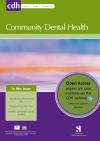Community Dental Health

- Cover Date:
- December 2014
- Print ISSN:
- 0265 539X
- Vol:
- 31
- Issue:
- 4
The impact of oral health status on the Oral Health-Related Quality of Life (OHRQoL) of 12-year-olds from children’s and parents’ perspectives
© BASCD 2014 doi:10.1922/CDH_3346Zhang05
The impact of oral health status on the Oral Health-Related Quality of Life (OHRQoL) of 12-year-olds from children’s and parents’ perspectives
Y.J. Li, Y.H. Gao and Y. Zhang
Objectives: To assess the effect of dental caries, periodontal status and dental fluorosis on the oral health-related quality life (OHRQoL) of 12-year-olds and to assess the agreement between parents and children on the children’s OHRQoL relative to the children’s oral health status. Methods: A two-stage sampling method was used to select a sample of 12-year-olds from Binzhou, China. Their oral health status was recorded using the DMFT, CPI and Dean’s Index. The Child Perception Questionnaire 11-14 (CPQ11-14) and the Parental Perception Questionnaire (PPQ) were administered to the children and their parents, respectively, to assess the children’s oral health-related quality of life. Results: The data used in the analysis were collected from 1,120 children. The prevalence of tooth decay was 31.6% and that of dental fluorosis was 29.7%; 4.1% of the children had healthy gums and 52.4% had dental calculus. There was a moderate to good correlation between the CPQ and PPQ (ICC=0.51-0.68). Having dental fluorosis and brushing teeth less than twice a day negatively influenced the emotional well-being domain of the CPQ, but was not related to this domain of the PPQ. Having calculus, dental fluorosis, brushing teeth less than twice a day and having dental visits negatively influenced the social well-being domain of the CPQ, but only tooth brushing was related to this domain of the PPQ. Conclusions: Children’s self-reported CPQ11-14 scores were more strongly associated with their oral health status and OHRQoL than their parents’ PPQ scores were, especially in the social and emotional well-being domains. Having caries, dental fluorosis or dental calculus negatively affected children’s oral health-related quality of life.
Key words: oral health, quality of life, dental caries, periodontal disease, dental fluorosis, China, CPQ, PPQ, OHRQoL
- Article Price
- £15.00
- Institution Article Price
- £
- Page Start
- 240
- Page End
- 244
- Authors
- Y.J. Li, Y.H. Gao, Y. Zhang
Articles from this issue
- Title
- Pg. Start
- Pg. End
- The European Association of Dental Public Health conference resolution on the control of e-cigarettes; Or “You have to be a bit crazy to carry on smoking conventional cigarettes when there are e-cigarettes availableâ€
- 194
- 195
- Weighing up the Weighted Case Mix Tool (WCMT): a psychometric investigation using confirmatory factor analysis
- 200
- 206
- Dentists’ views on the effects of changing economic conditions on dental services provided for children and adolescents in Iceland
- 219
- 223
- Utilisation of oral health services provided by non-dental health practitioners in developed countries: a review of the literature
- 224
- 233
- The impact of oral health status on the Oral Health-Related Quality of Life (OHRQoL) of 12-year-olds from children’s and parents’ perspectives
- 240
- 244
